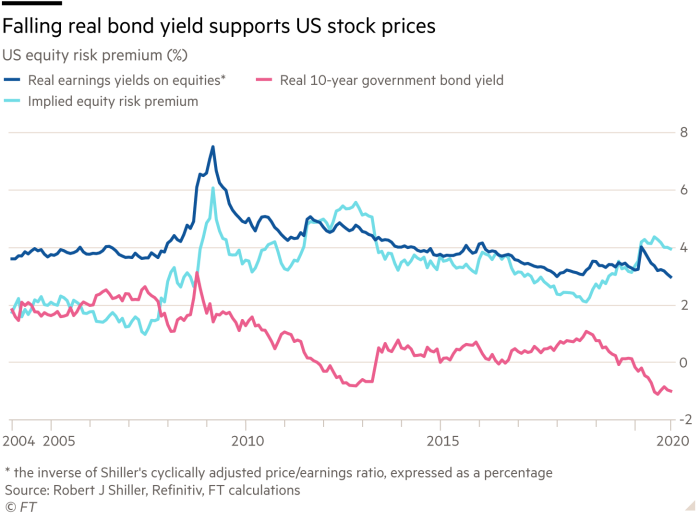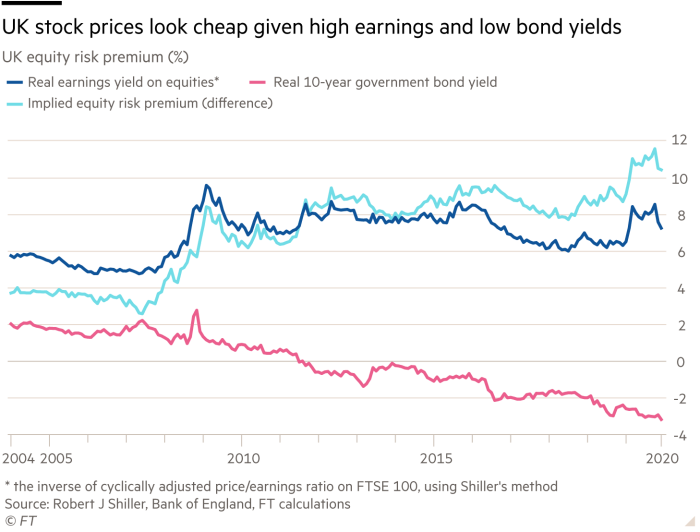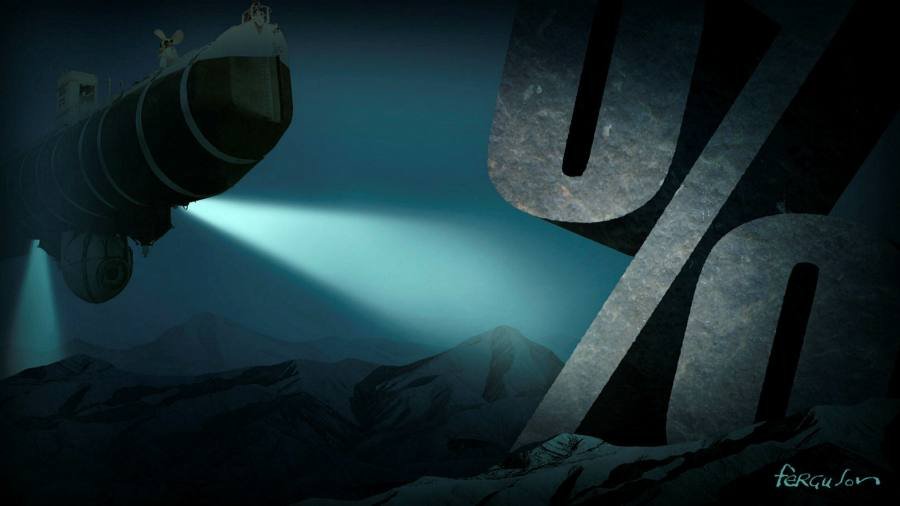[ad_1]
Are stock markets, particularly the US market, in a bubble that is positive to pop? The reply is dependent upon prospects for company earnings and rates of interest. Supplied the previous are sturdy and the latter ultra-low, stock costs look affordable.
The most effective-known measure of market worth — the “cyclically adjusted price/earnings ratio” of Yale’s Nobel laureate, Robert Shiller — is certainly flashing purple. One can invert this metric, to point out the yield: on the S&P Composite index, this is simply 3 per cent right this moment. The one years since 1880 it has been even decrease have been 1929 and 1999-2000. Everyone knows what occurred then. (See charts.)

One other worth is additionally exceptionally low by previous ranges: rates of interest. The short-term nominal rate of interest is close to zero within the US and different high-income economies. US short-term actual rates of interest are about minus 1 per cent. Actual yields on US 10-year Treasury-inflation-protected securities are minus 1 per cent. Within the UK, yields on related securities are about minus 3 per cent.
Desired returns on equities must be associated to the returns on such supposedly protected property. This relationship is referred to as “the equity risk premium”, which is the surplus return sought on equities over the anticipated returns on authorities debt. This premium can’t be measured straight, because it solely exists in traders’ minds. However it may be inferred from previous expertise, as defined in a 2015 paper by Fernando Duarte and Carlo Rosa for the New York Federal Reserve. Extra just lately, within the Credit score Suisse World Funding Returns Yearbook 2020, Elroy Dimson, Paul Marsh and Mike Staunton of the London Enterprise Faculty estimated the surplus return on world shares over bonds at 3.2 share factors between 1900 and 2020. For the UK, the surplus is estimated at 3.6 share factors; for the US, at 4.4 share factors.

Are these extra returns according to what folks initially anticipated? We have no idea. However they’re a place to begin. The premium demanded now is perhaps decrease than that looked for a lot of the previous 120 years. Company accounting has improved drastically. So, too, has macroeconomic stability — no less than by the wretched requirements of the primary half of the twentieth century. Furthermore, the power to carry diversified portfolios is far better now. Such modifications counsel the danger premium, usually believed to be extreme, ought to have fallen.
The Credit score Suisse research estimates combination actual returns on shares and bonds in 23 markets weighted by market capitalisation firstly of every yr. It exhibits, curiously, that the surplus return of equities since 1970 have been very low and since 1990 detrimental. However this is due to very excessive actual returns on bonds, as inflation and actual rates of interest collapsed. Wanting forward, it estimates the potential extra return of equities at 3.3 share factors. This is the identical because the long-run historic common.

Estimates of Shiller’s metric don’t exist for such prolonged intervals for non-US stock markets. However estimates will be made for the reason that early 2000s. The cyclically adjusted earnings yield is at present 7.6 per cent on the FTSE 100, 5.4 per cent on the DAX 30 and 4 per cent on the Nikkei 225. At present actual rates of interest on long-term bonds, the implied fairness return premium is thus over 10 share factors within the UK, over 7 share factors in Germany and 4 share factors in Japan and the US. The UK market appears to be like extraordinarily low-cost right this moment, maybe due to the Brexit lunacy. Japan and the US look properly valued, however not, by historic requirements, overvalued.
Additional {support} for the rationality of the US market right this moment is that 55 per cent of the rise within the S&P 500’s market worth over the previous 12 months is attributable to features within the data and expertise sector. This is sensible, given US dominance in these areas and the technological shift of 2020. We also needs to observe that actual rates of interest beneath zero make future earnings extra helpful than earnings right this moment, by way of current worth. Wanting by means of the short-term affect of Covid-19 is sensible.

Given the rates of interest, then, stock markets should not overvalued. The massive questions are whether or not actual rates of interest will soar, and the way quickly.
Many imagine that ultra-low actual charges are the product of unfastened financial insurance policies over a long time. But, if that have been proper, we might count on to see excessive inflation by now.
A greater speculation is that there have been massive structural shifts in world financial savings and funding. Certainly, Lukasz Rachel of the Financial institution of England and Lawrence Summers of Harvard argued in Brookings Papers 2019 that actual financial forces have lowered the non-public sector’s impartial actual rate of interest by 7 share factors for the reason that Seventies.

Will these structural, decades-long traits in the direction of ultra-low actual rates of interest reverse? The reply must be that actual rates of interest usually tend to rise than fall nonetheless additional. In that case, long-term bonds can be a horrible funding. But it surely additionally is dependent upon why actual rates of interest rise. In the event that they have been to take action as a product of upper funding and quicker development, sturdy company earnings may offset the affect of the upper actual rates of interest on stock costs. If, nonetheless, financial savings charges have been to fall, maybe due to ageing, there can be no such offset, and stock costs may grow to be considerably overvalued.
Some main stock markets, notably the UK’s, do look low-cost right this moment. Even US stock costs look affordable, valued towards the returns on safer property. So will the forces which have made actual rates of interest detrimental dissipate and, in that case, how quickly? These are the large questions. The solutions will form the longer term.

[ad_2]





